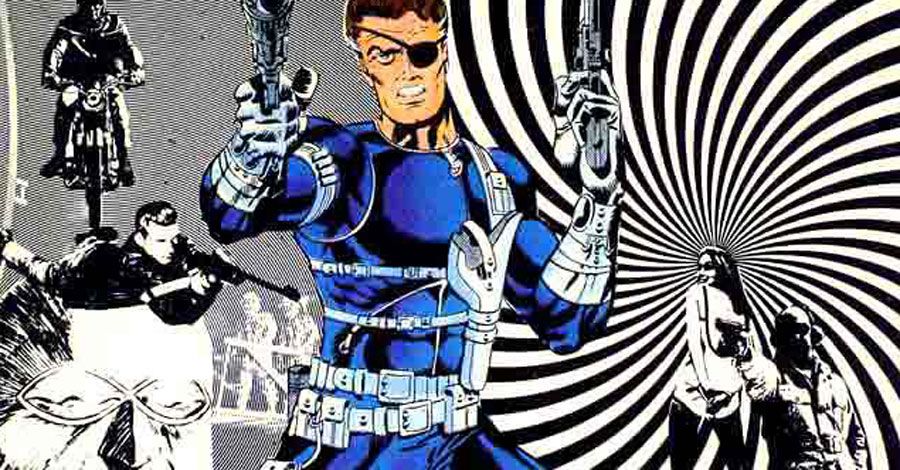A spry and svelte Jim Steranko ("Nick Fury, Agent of S.H.I.E.L.D.") appeared at San Diego Comic-Con International 2014 to discuss his legendary career in comics including his training as an artist, his relationship with Stan Lee and his fight with "Batman" creator Bob Kane.
Steranko arrived in San Diego hot off a spotlight article in the "Entertainment Weekly" Comic-Con preview issue and a review of ABC's "Agents of S.H.I.E.L.D." he wrote for "The Hollywood Reporter." IDW has also recently released an artist's edition of Steranko's Nick Fury work for Marvel.
"I grew up in a pretty tough neighborhood and you had to survive," said Steranko, who hails from Pittsburgh. "I used to draw on the inside of envelopes, that's where I started." On cold nights, he would use his fingers to sketch in ice on the windows.
"I learned to draw from the comics," said Steranko. Alex Toth, John Romita and Bill Everett particularly influenced him. "On the other hand I got my story telling chops from film, from the cinema," he continues. "I always said that my teachers were William Wellman, Orson Welles, Hitchcock and the guy that taught the most of all, Michael Curtiz."
At school, however, Steranko struggled. He was "an honor student in school until about 8th grade. Then I gotta into some pretty tough company then I couldn't take any books home," he said. "There were a group of guys in a neighborhood gang that ambushed me on my way home from school every night."
Steranko was left to educate himself. He continued to learn art and eventually found his way into advertising in New York City. "When I got into comics I was working at an ad agency as an art director and I made a lot of money," he said. Comics, though, were worth the loss of income. "I was there to tell stories. I brought Marvel an array of ideas that were fresh and new," Steranko continued.
The creator believes his lack of a formal education allowed his mind to stay open. "That's probably because I never was trained. I never had an art lesson. I was just a poor kid. I barely made it through my teen, he said. "Every time I brought an idea in, I'd always get flak."
His inventiveness led him to unique experiments and arguments. Over Stan Lee's initial objections, Steranko designed a white cover for "Nick Fury, Agent of S.H.I.E.L.D." #4. Because, "when everything shouts, nothing shouts" on the stands. Steranko also wrote unusually long arc for 'Strange Tales" that ran for an unheard of nine issues. Once again, after Lee's objections, Steranko made an usual move. He wrapped up the long arc with a four-page spread.
The contentious relationship between Lee and Steranko came to a head, however, over a one-shot. "I decided to do a mystery or horror story. I did what I consider my most innovative story. I called it the 'Lurking Fear at Shadowhouse' after [HP] Lovecraft. And I got into an argument with Stan," said Steranko. "I said, 'Please don't edit this book, this story.' It was only a seven-page story."
Steranko threatened to quit if Lee changed one word. "The only time I've ever seen Stan angry was that moment. He fired me on the spot." A couple months away from Marvel and the phone rang at Steranko's house. The two hashed out their disagreement and Steranko went back to Marvel. Years later, Lee would call Steranko a son.
Although his relationship with Lee could become contentious, Steranko's fight with Bob Kane was far more inflammatory. "I'd written both volumes of my history of comics including my 'Batman' section," said Steranko. Although, he had never met Kane. "So this guy brought me over to this group of about five guys. So, there was one guy who was wearing patent leather shoes and ascot, at Comic-Con." That was Kane. After a brief conversation, "Bob turned around and said, 'See you later Jim, baby,' and he cuffed me across my face, and the doors closed before I could do anything."
"I tried, I really tried to sleep that night. Couldn't do it," said Steranko. He set out to look for Kane the next day. His opinion of the "Batman" creator dropping along the path. "I always said that 'Batman" was the comic book version of "The Shadow.'" Finally, Steranko found him. "I bitchslapped him across the face and I said 'See you later Bob, baby.'" And, in case there was any confusion over Steranko's motives. "This was what I regret about the whole incident, is that he didn't take a swing at me, because you would have seen him on the Bat-floor."

